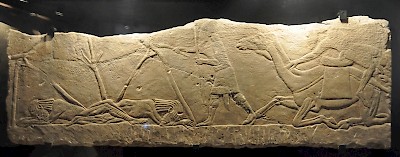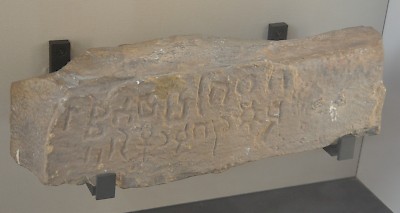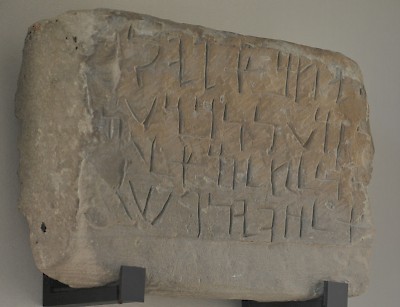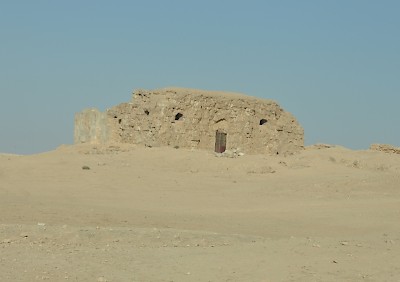Arabia Deserta
Arabs: the people living in the country to the west and south of Mesopotamia.

Although the name "Arab" means something like "nomad", most Arabs were sedentary farmers and lived in towns. In Antiquity, their land can be divided into several zones:
- Arabia Deserta: the nomadic interior (Saudi Arabia and the desert of Syria/Iraq);
- Arabia Felix: the towns and cities in the regions bordering on the Indian Ocean (modern Yemen); the inhabitants never considered themselves Arabs;
- Nabataea in the northwest, where the people called themselves Nabataeans and had Petra as their capital.
The domestication of the dromedary allowed the Arab nomads to move over greater distances. Trade along the Incense Route from Yemen to Syria started to create some kind of homogenity. At the same time, it allowed Arab tribes to move out of their homelands. They gradually took over an urban periphery in Lebanon, Syria, and Iraq. The rise of the Umayyad Caliphate in the seventh century CE marks the final stage of this process.
Arabia Deserta

The nomadic tribes from Arabia Deserta, in Akkadian called Aribi, frequently invaded the surrounding countries - i.e., Arabia Felix and Mesopotamia -, where they sometimes managed to settle. Hardly anything about these isolated "people without history" is known, although it seems certain that they became dromedary riders in the tenth or ninth century BCE. Sources from Assyria and Babylonia mention tribes with names like Kedar, Massa, Nebayot, Thamud, all living in the northern part of the Arabian Peninsula. The Bible mentiones the Midianites, who lived in the western part of the peninsula.
The Arabs spoke various Semitic languages: Lihyanite or Dedanite (in the Dedan Oasis), Thamudic (i.e., northern Arabic), Nabataean, Minaean, and Sabaean. The dominant language along the Incense Route must have been Minaean. They were written in various scripts. The modern Arabic alphabet is derived from the Nabataean script.

Among the oldest references to Arabs is the account of the battle of Qarqar in 853 BCE, in which the Assyrian king Salmanasser claims to have defeated a Syrian coalition. Somewhat younger are the reports about a kingdom named Aribi, which is mentioned for the first time during the reign of Tiglath-Pileser III (r.745-727), and was ruled by a queen. Aribi was an Assyrian vassal until the second half of the seventh century. Later, the Arabs were subdued by the Babylonian king Nabonidus, who made the oasis of Tayma his capital and reached Yathrib (modern Medina).
In the course of time, the Arabs infiltrated the urban periphery. In the late fourth century BCE, the tribe of the Nabataeans had taken over southern Jordan. In the second century, it became a real kingdom. Its capital was Petra. Another group, the Ituraeans, settled in Chalcis in the Bekaa valley (eastern Lebanon). In the Parthian and Roman periods, other Arab dynasties ruled towns in what is now northern Saudi Arabia (Hegra, Tayma, Duma, Gerrha), eastern Syria (Palmyra, Emesa, Resafa), northwestern Iraq (Hatra) and southern Iraq (Charax).
The Ghassanids

In Late Antiquity, there were two powerful federations: the Ghassanids and the Lakhmids, who were allied to the Roman/Byzantine Empire and to the Sasanian Persians. The Lakhmids controled the eastern part of the desert between Syria and Mesopotamia and the southwestern shore of the Persian Gulf down to what is now Qatar; the Ghassanids controled the desert from the Euphrates in the north to Tayma and Dedan in the south. Their capital was Resafa in East Syria.
The Byzantine emperor Justinian (r.527-565) recognized one of their leaders, Al-Harith, as "king of the Arabs" (r.529-569); his son Al-Mundhir succeeded him and was recognized as well. Because the emperor Maurice (r.582-602) did not want a Monophysite Christian as commander of an important section of the eastern frontier, he exiled Al-Mundhir to Sicily.
The disappearance of Ghassanid leadership made Rome’s eastern border vulnerable. When, in 602, war broke out between the Sasanian king Khusrau II and the Byzantine usurper Phocas, Syria was indeed attacked. This war was to last for a quarter of a century. Both empires were exhausted and an easy target for the great Arab conquests that started in the second quarter of the seventh century. One of the consequences was the rise of a shared faith, Islam, and a shared language, Arabic.